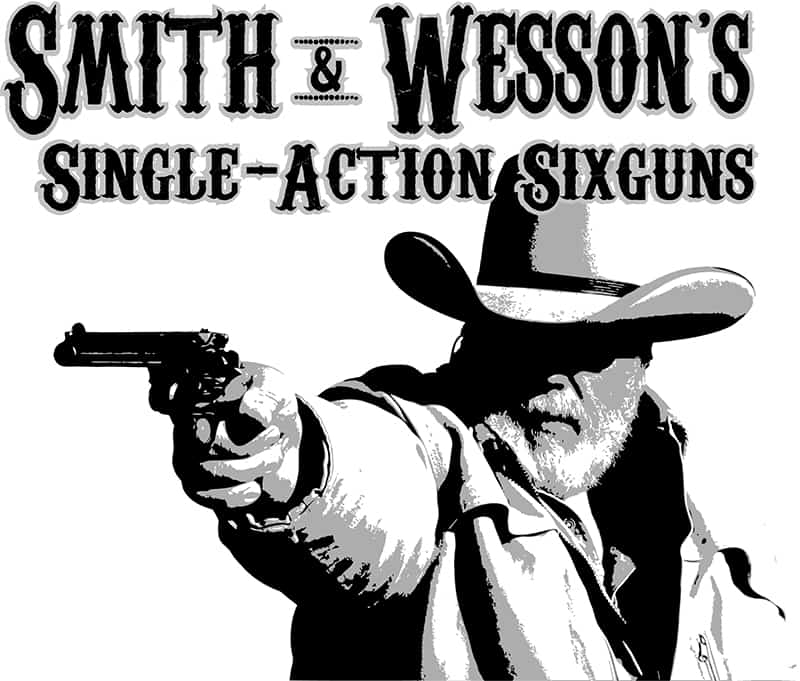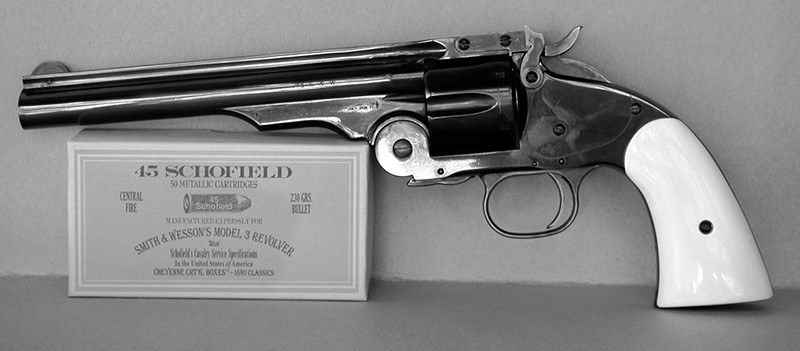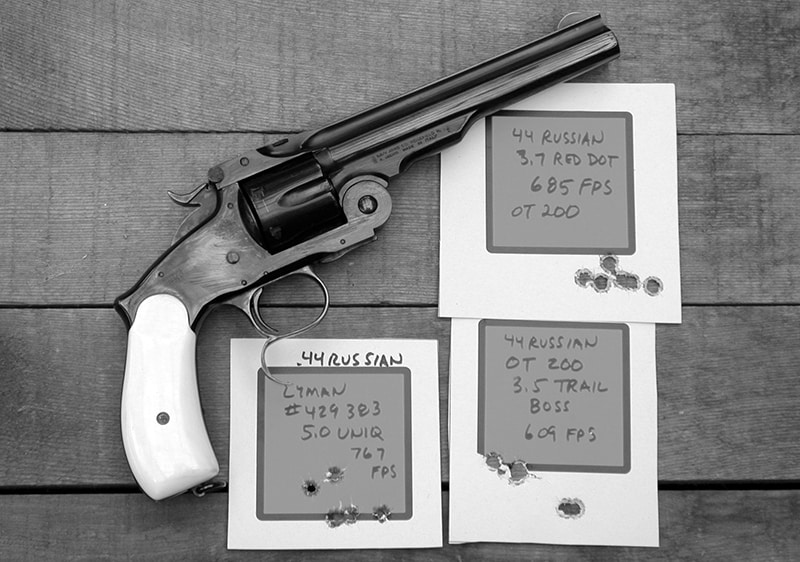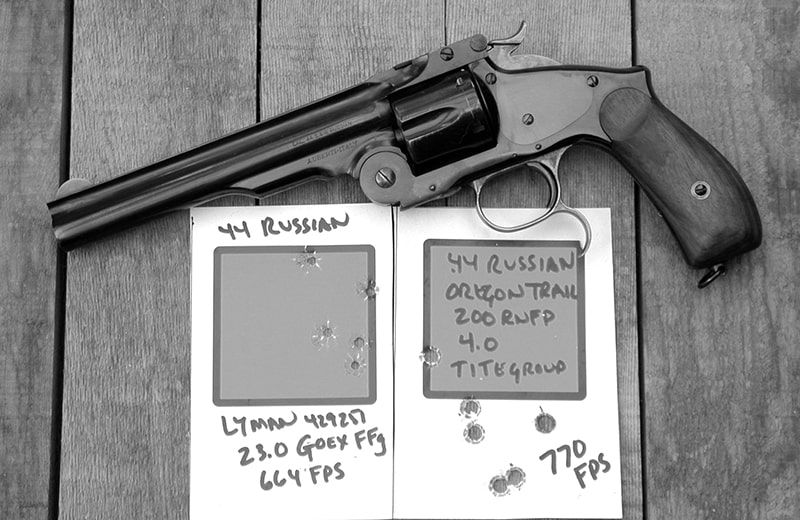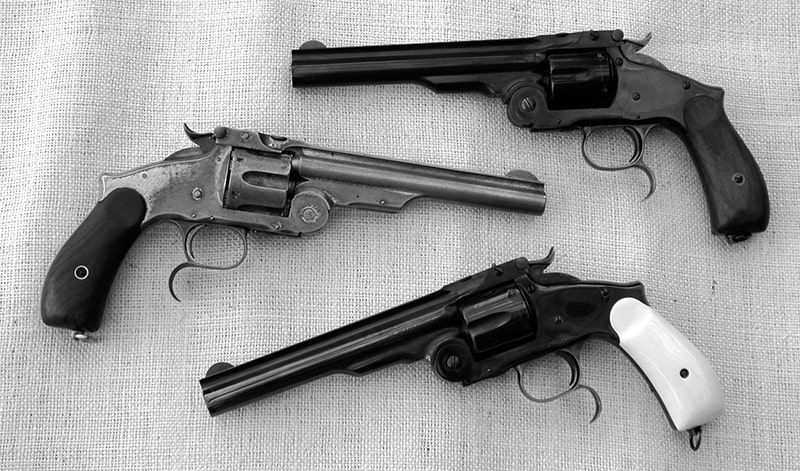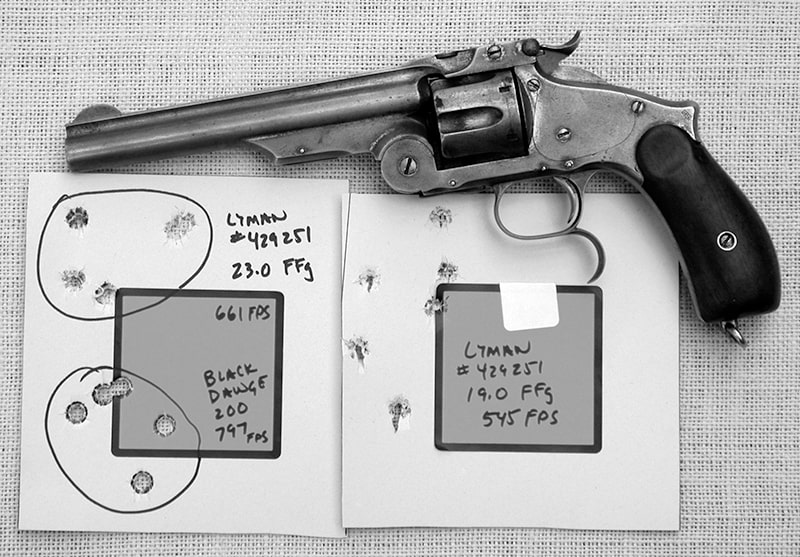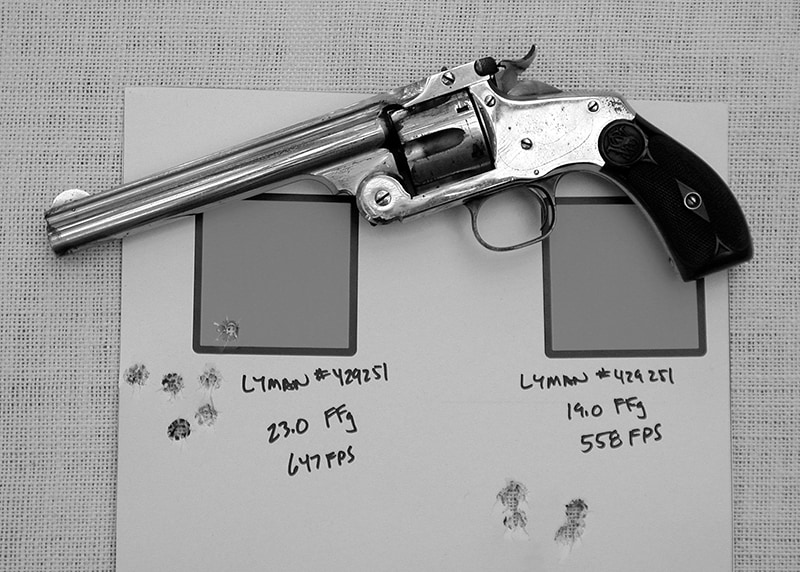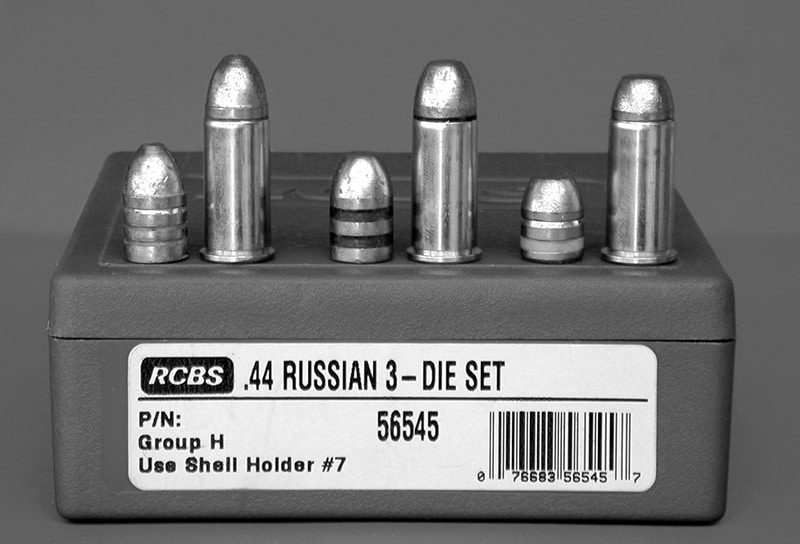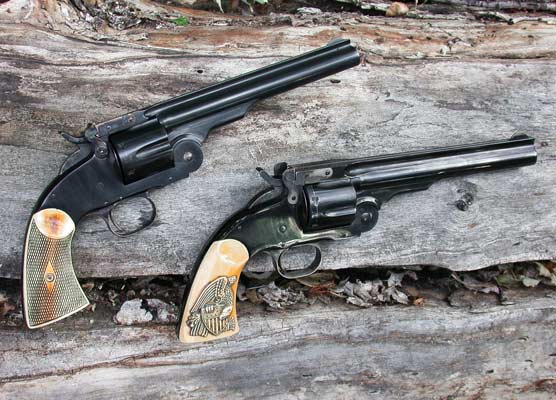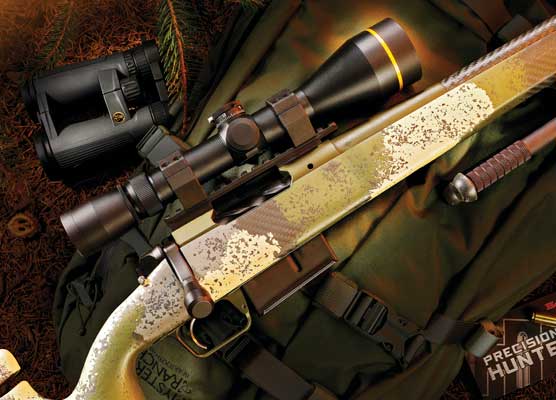Smith & Wesson's Single-Action Sixguns
They, Too, Helped Win The West
During the 1930s and 1940s, B-Western movies were cranked out by the hundreds and every young boy had his particular cowboy hero. I was born too late to catch most of these wonderful old movies in the theater, however, what I didn’t see on the silver screen in the late 1940s I soon saw on television in the early 1950s. I was especially fascinated by the sixguns and leather rigs used by each hero. All of this certainly had a great effect on me when I started buying my own single-action sixguns starting with a Ruger .22 Single-Six in 1956 and soon followed by a 1st Generation .38-40 Colt Single Action Army, which was then very quickly joined by the first 2nd Generation .45 Colt SAA to arrive in my area.
Within a year I had a pair of 7 1⁄2″ Colts and a fast-draw rig by Ray Howser of the Pony Express Sport Shop in Encino, California. Ray is still alive and I had the pleasure of speaking to him recently. I practiced with those Colts every day; fast drawing and spinning them end over end and back into the holsters. With these two Colts and a pair of Ruger Blackhawks, a 4 5⁄8″ .357 and a 6 1⁄2″ .44 Magnum, I was sitting on top of the Single Action Sixgunning World. I knew Colt had been making great single actions since 1836 and Ruger since 1953, and even Remington had made a few in the last quarter of the 19th century, but I was soon in for a shock. Every cowboy hero carried a Colt Single Action, in a few cases a Colt Bisley Model and sometimes even a Colt made to look like a Remington. What else was there? I soon found out.
The Other Single Action
My neighbor who was in his 30s also loved single-action sixguns with his number one single action being a custom Colt Single Action from the early 1900s rebarreled and recylindered to .44 Special. The grip frame on his Colt was different from those on mine in that it was a much longer version taken from his Colt 1860 Army, which now, in turn, wore the standard Single Action Army grip frame. I filed that information away in the back of my mind and would use it nearly 50 years later to add 1860 Army grip frames to standard Single Action Army Models.
His old Colt .44 really captured my imagination but nothing like the next sixgun shown. It was a single action all right, and it was in .44 caliber, but it was not a Colt. Now by this time I had fired the then-brand-new Smith & Wesson .44 Magnum and also had a Model 1917 S&W .45 ACP and a 2nd Model Hand Ejector .455 converted to fire .45 Colt. These two old sixguns convinced me Smith & Wesson made superb double actions and I was about to find out they also made some of the most beautiful single actions ever to come from a factory. His other single action was a .44 Russian made by Smith & Wesson. Up to that point I did not even know Smith & Wesson made single actions, but it did not take much examination for even my youthful eyes and fingers to discover what a beautifully crafted sixgun the Smith & Wesson .44 Russian really was. There was no doubt the Colt Single Action Army was a workhorse. On the other hand, the Smith & Wesson Single Action was definitely a thoroughbred.
Digging For Info
Always wanting to know everything I could about single-action sixguns, I began looking for printed material about Smith & Wesson revolvers, especially the old single actions. Today it is easy to find information on Smith & Wesson single-action revolvers including two recently published works, The Standard Catalog of Smith & Wesson 2nd Edition, by Jim Supica and Richard Nahas (Krause 2001), and Smith & Wesson Sixguns of The Old West by David Chicoine (Mowbray 2004). Both are superb, but 50 years ago it was not so easy.
It would be several years before Neal and Jinks published their first book on Smith & Wesson revolvers. Once that volume appeared I discovered Smith & Wesson had made thousands upon thousands of single-action revolvers beginning with the first .22, a seven-shot tip-up, in 1857. This was the Model No. 1. It was followed by Models No. 11⁄2, No. 2, and then beginning in late 1869, the Model No. 3 .44 S&W American. This was the first cartridge-firing big-bore revolver produced in an American factory. It became the first of four basic Smith & Wesson single-action big-bore sixguns. The others were the Russian Model, the New Model No. 3, and in between these two, the Model No. 3 Schofield.
The First Big Bore
The advent of the American Model brought two great advances. Cartridge cases were now made of brass instead of copper and were centerfire instead of rimfire. Loaded with 25 grains of black powder and a 218-grain bullet, the .44 Smith & Wesson American gained a reputation for accuracy. It would soon get even better. In December of 1870, the U.S. Government ordered 1,000 S&W Americans for military use, and once the Cavalry was outfitted with .44 Americans, Smith & Wesson soon began to receive orders from around the country. Until the arrival of the Smith & Wesson .44, troops were equipped with the relatively slow-to-load Civil War-era Colt 1860 Army Model .44 percussion revolver. The S&W took a giant leap forward in the loading and unloading of a trooper’s revolver. As the lock atop of the frame was unlatched, the barrel swung down, empties were automatically ejected, and six new rounds could be loaded in the cylinder and the barrel swung to relock. The whole operation of loading and unloading this first .44 Smith & Wesson is even faster than a modern swing-out cylindered revolver.
Russian Improvements
The United States Cavalry was not the only military force to look at the Smith & Wesson. In 1871, the Russians ordered 20,000 S&W Americans and were about to make the third major change in cartridges as the Russians asked for several major improvements. Until this time cartridges were loaded with both bullets and the cartridge case had the same outside diameter. This was possible by the use of a bullet with a smaller diameter heel fitting inside the case. The Russians specified a bullet made of uniform diameter, lubrication placed in grooves in the bullet inside the cartridge case, and the cartridge case crimped into a groove on the bullet. The result was the legendary .44 Russian, father of the .44 Special and grandfather of the .44 Magnum.
The Russians also made several improvements to allow better control and comfort in shooting. The square stock and grip frame of the American was rounded and diminished in diameter, a hump was added at the top of the backstrap to prevent the grip from rotating in the hand when on firing, a lanyard ring added to the butt for security, a spur added to the bottom of the triggerguard for a steadier hold and aim, and the 8″ barrel was cut to a more convenient 61⁄2″. It was still not a perfect revolver, however the Russian improvements had set it squarely on a path to perfection.
Old Gun, New Ammo
The S&W Model No. 3 was originally available chambered in either .44 Henry Rimfire or .44 Smith & Wesson American. The Henry ammunition is nearly impossible to find today and if so would be too expensive to shoot. The same situation exists with the .44 American cartridge except, since it is a centerfire, it can be made from .41 Magnum brass. Heel bullets are made from the now out-of-production RCBS 44 S&W bullet mold and .41 Magnum brass is cut to .91″. There is no way to crimp these cases with conventional .44 American dies as offered by C&H. Chicoine shows an example of a handheld crimping tool in his book and my friend Denis Fletcher came up with an excellent idea which I call the .44 Guillotine. Mounted on a shell holder to fit the RCBS Rock Chucker press, it actually looks like a miniature guillotine and the loaded cartridge case enters horizontally in the left-hand as the right-hand operates the handle of the loading press to apply pressure and a crimp. The .44 Russian is a much better idea.
S&W .44 Evolution
The .44 American went through several Russian improvements eventually becoming the New Model Russian, perhaps better known as the Model No. 3 Russian. Several years ago, when returning from the Linebaugh Seminar and Winchester Gun Show in Cody, Wyoming, my wife and I stopped in Falls for a break. She, not yet having started her own collection of top-break revolvers, spotted a quilt store, while I went down the street to a local gunshop where I found several excellent Smith & Wesson revolvers resulting in greatly applied pressure to my plastic card. The first sixgun was a .38/44 Outdoorsman in excellent condition and at a most reasonable price. It left the gunshop with me, along with my first single-action Smith &Wesson, a Model No. 3 Russian dated 1874. The finish is mostly gone, however the barrel is in good shape and it locks up and functions very well, certainly enough to allow it to be safely shot with black-powder loads. The mating of the top-break locking parts was a trifle loose, and gunsmith Glen Kyser did a little welding and filing and it is now as tight as it was when it left the factory more than 125 years ago.
Original Model No. 3 Russians may be tough to find in good shooting shape without commanding high-collector dollars, however Navy Arms offers an excellent shooting replica of the New Model Russian chambered in the original .44 Russian cartridge. The Navy Arms Model No. 3 Russian is finished overall in a deep blue-black finish set off with a case-colored hammer, triggerguard and locking latch. The Model No. 3 Russian is also offered directly by Uberti. Both versions come with factory stocks of smooth European walnut, however my personal Navy Arms New Model Russian has been fitted with Ultraivory grips from Eagle Grips. Ultraivory, while a synthetic material, looks like real ivory, with milky-white color and ivory-type grain. They also provide good contrast to the dark-blue finish of the gun.
The Epitome
I earlier mentioned my friend’s .44 Russian, which turned out to be a New Model No. 3, the third of the .44 Smith & Wesson big-bore, top-break single actions. After seeing this magnificent specimen, I began to watch to see if anyone actually carried a Smith & Wesson single action in the movies or on television. I have been watching for nearly 50 years and they are very few and far between. The first one I noticed was Robert Culp as Texas Ranger Hoby Gilman in the TV series Trackdown. Culp must have really liked the Smith & Wesson, as he also used one in the movie Hannie Caulder. Tyrone Power as Jesse James carried an S&W Model No. 3 in a shoulder holster, a 7 1⁄2″ Colt on one side, the Smith on the other, and Kurt Russell as Wyatt Earp carried a Smith & Wesson in some parts of the movie Tombstone.
The Smith & Wesson New Model No. 3 was way ahead of its time. It is so precisely fitted it demands smokeless powder for perfect functioning, however all of the frames of these guns were built in the black-powder era and should only be used with black powder. Definitely a Catch-22. The machining and tolerances used in their manufacture were so precise they are easily fouled and work very sluggishly after very few rounds of black-powder loads. The only answer is to keep them clean.
One of the local gunshops had just taken in a New Model No. 3 .44 Russian in excellent condition a few years ago. Diamond Dot did a little bargaining and it became ours. Both this New Model No. 3 and the earlier mentioned original Model No. 3 Russian are used only with blackpowder loads. They are much too valuable to take a chance on ruining them using smokeless powder. Thanks to Starline we have modern solid head .44 Russian brass available to reloaders, and although several companies now offer loaded .44 Russian ammunition it should only be used in modern replicas. Reloaders can produce their own .44 Russian ammunition for the old original guns using either black powder or a blackpowder substitute.
The .45s
In between the Model No. 3 Russian and the New Model No. 3, Smith & Wesson deviated from .44 caliber with the .45 S&W-chambered Schofield. The Schofield, coming about as an improvement to Russian Model No. 3 and a competitor to the Colt Single Action Army, is named for Major George Schofield who came up with the improvements. The Smith & Wesson Model No. 3s had a great advantage in ease of unloading and reloading, but required two hands to operate the latch on the top of the barrel. Major Schofield, assigned to the 10th Cavalry, changed the Smith & Wesson latch from the back of barrel assembly to the main frame allowing it to be pushed in with the thumb of the shooting hand rather than opened with the offhand. This proved to be a great advantage over the Colt when operated by a man on horseback. In 1873, a test was set up placing the Schofield Model Smith & Wesson against the Colt Single Action Army. While mounted on a moving horse, the horseman had to empty the sixgun, remove six cartridges from his belt pouch and reload.
Can You Spell F-A-S-T?
It took 26 seconds to unload the Colt and it was then reloaded in 60 seconds. The improved Smith & Wesson Schofield took two seconds to unload and it was reloaded in 26 seconds. One minute and 26 seconds for the Colt and only one-third as much total time to unload and reload for the Schofields. The Army ordered Schofields, however they did not drop the Colt Single Action Army. Both sixguns, the Colt and the Smith & Wesson, were chambered in .45 caliber, however the cylinder of the Schofield was shorter than that of the Colt .45 and would not accept the full-length .45 Colt cartridge but rather a shortened .45 S&W round. The Colt could handle the .45 S&W cartridge, however the Schofield would not chamber the longer .45 Colt. It is easy to see the problem this would be if Cavalry units equipped with .45 Schofields received unusable .45 Colt ammunition.
Whether because of the ammunition problem or the fact Smith & Wesson was simply too busy producing revolvers for the Russians and other markets to produce more Schofields, the Schofields became government surplus in 1880 and many of the 7″ Schofields had their barrels cut back to 5″ and became unofficially known as the Wells Fargo Model. Gunfighters on both sides of the law carried Schofields and it’s definitely known that Schofield Number 366 belonged to Jesse James and may have been carried by the famous outlaw even when Bob Ford shot him in the back.
Schofield Resurrected
Thanks to the late Val Forgett, who was responsible for the replica of the Model No. 3 Russian, we also have a replica of the Smith & Wesson Model 1875 Schofield manufactured by Uberti. It is relatively faithful to the original Schofield except the cylinder is longer and it is chambered, not for what was the obsolete .45 S&W just a few short years ago, but the .45 Colt. Smith & Wesson has also recently produced a Schofield, the Model 2000 issued on the 125th anniversary of the original Schofield. The original Smith & Wesson Schofield was only produced from 1875-1877 with less than 10,000 being produced. The Smith & Wesson factory-issued Schofield Anniversary Model came from Smith & Wesson’s Custom Shop, the Performance Center, staying as close to the old original design as much as possible with today’s considerations including a frame-mounted firing pin, however they kept the authentic cylinder length only accepting the .45 S&W, or .45 Schofield cartridge.
Smith & Wesson single-action sixguns were a vital part of our frontier history. The Americans were produced from 1870-1874, the Model No. 3 Russian, 1873-1878; the Schofield, 1875-1877, and the New Model No. 3 from 1878 all the way to 1912. Today, we have replicas of both the Model No. 3 Russian and the Schofield Model available, and Beretta now makes the Laramie patterned after the New Model No. 3, all allowing today’s shooters to enjoy great single-action sixguns originally produced by S&W, now mostly considered as number one when it comes to double-action revolvers.

Get More Revolver Content Every Week!
Sign up for the Wheelgun Wednesday newsletter here:
